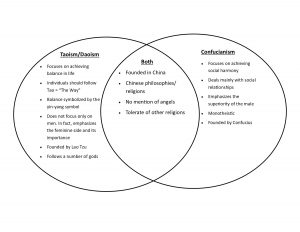On page 54 of Tao Te Ching, the passage reads:
“Therefore,
Through self contemplate self,
Through family contemplate family,
Through community contemplate community,
Through country contemplate country,
Through world contemplate world.
How do I know the world?”
This was my favorite reading from the Tao Te Ching. The final line is impactful in that it demonstrates how you can never really know the world completely and there is always an opportunity to learn more. The first several lines to me demonstrate the importance of being curious. Having strong roots does not have to hinder curiosity but can in fact aid curiosity. At Butler, I am always pushed by professors to use my prior knowledge and resources while pushing myself to be curious and stimulate my own learning. This course is an excellent example of one of those courses. The course itself provides the foundation for learning about China and Islam while we are encouraged to pursue other materials to stimulate new learnings in areas we are interested in.
A marketing course that I had last semester here at Butler proved the importance of being curious. Using the prior rooted knowledge, we had of the marketing world, we prepared a creative marketing strategy using a target market and topic we were interested in. Not only did this solidify the knowledge we had about marketing, but it stimulated growth in a brand-new area. This was a very valuable course and a great way to learn, which leads me to believe this course will be similar.
Taoism teaches balance is important. Roots of knowledge and the unknown might seem like opposites, but Taoism teaches embracing these opposites is important. This passage is a great demonstration of how important curiosity is and how it can be used in conjunction with strong roots.
